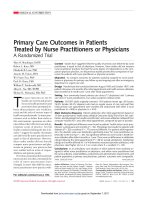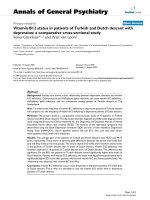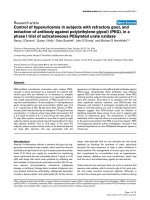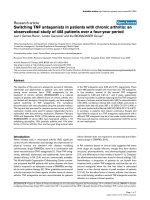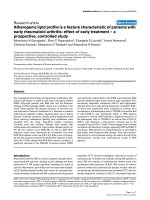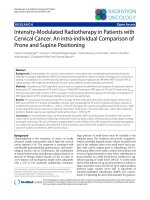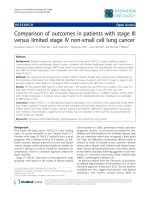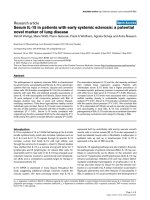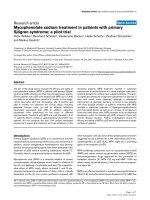Báo cáo y học: "Insular cortex involvement in declarative memory deficits in patients with post-traumatic stress disorder" potx
Bạn đang xem bản rút gọn của tài liệu. Xem và tải ngay bản đầy đủ của tài liệu tại đây (403.75 KB, 9 trang )
BioMed Central
Page 1 of 9
(page number not for citation purposes)
BMC Psychiatry
Open Access
Research article
Insular cortex involvement in declarative memory deficits in
patients with post-traumatic stress disorder
Shulin Chen*
1,2,3
, Lingjiang Li
3
, Baihua Xu
2
and Jun Liu
3
Address:
1
Department of Medical Psychology, the Seventh Hospital of Hangzhou, Zhejiang, PR China,
2
Department of Psychology, Zhejiang
University, Hangzhou, Zhejiang, PR China and
3
Mental Health Institute, the Second Xiangya Hospital, Central South University, Changsha,
Hunan, PR China
Email: Shulin Chen* - ; Lingjiang Li - ; Baihua Xu - ;
Jun Liu -
* Corresponding author
Abstract
Background: Neuroimaging studies have proved that hippocampus relate to the deficient of
memory in patients with post-traumatic stress disorder (PTSD). Many studies in healthy subjects
also shown that insular cortex (IC) be involved in the declarative memory. This study was designed
to investigate whether insular cortex is involved in declarative memory deficits in patients with
PTSD.
Methods: Twelve subjects with PTSD and 12 subjects without PTSD victims underwent functional
magnetic resonance imaging and magnetic resonance imaging. All subjects performed encoding and
retrieval memory tasks during the fMRI session. Voxel-based morphometry method was used to
analyze gray-matter volume, and the Statistical Parametric Mapping (SPM2) was used to analyze
activated brain areas when performing tasks.
Results: Grey matter volume was significantly reduced bilaterally in the insular cortex of PTSD
subjects than non-PTSD. PTSD group also had lower level of activation in insular cortex when
performing word encoding and retrieval tasks than non-PTSD group.
Conclusion: The study provides evidence on structural and function abnormalities of the insular
cortex in patients with PTSD. Reduced grey-matter volume in insular cortex may be associated
with declarative memory deficits in patients with PTSD.
Background
The insular cortex (IC) is a region located in the centre of
the cerebral hemisphere. It processes sensory input in all
modalities: gustatory, olfactory, auditory, visual and som-
atosensory [1,2]. Although IC is considered primarily as a
taste area and is involved in conditional taste aversion and
taste recognition, some studies demonstrated the involve-
ment of IC in face recognition, tactile recognition and
working memory[3,4]. Results of two animal studies also
suggest that the IC is involved in declarative memory. For
instance, Bermudez-Rattoni reported that IC is involved
in consolidation of memory, and the study by Miranda
suggested that cholinergic transmission in the IC is neces-
sary for the acquisition and consolidation of contextual
memory[5,6].
Studies on PTSD suggest a specific association between
the traumatic stress and changes in memory functions [7-
Published: 18 June 2009
BMC Psychiatry 2009, 9:39 doi:10.1186/1471-244X-9-39
Received: 31 August 2008
Accepted: 18 June 2009
This article is available from: />© 2009 Chen et al; licensee BioMed Central Ltd.
This is an Open Access article distributed under the terms of the Creative Commons Attribution License ( />),
which permits unrestricted use, distribution, and reproduction in any medium, provided the original work is properly cited.
BMC Psychiatry 2009, 9:39 />Page 2 of 9
(page number not for citation purposes)
9]. Patients with PTSD may suffer from long-term mem-
ory deficits. In Archibald and Tuddenham's follow-up
study, many veterans of World War II still suffered from
episodes of 'black-outs' or impairment of explicit mem-
ory[10]. Intrusive memories and impoverished memories
are common complaints among patients with PTSD[7].
Intrusive memories are diagnostic symptoms in patients
with PTSD; they were easily triggered by ordinary stimuli
such as low-flying airplane or loud noise, or anything that
relives any aspect of the traumatic event. These intrusive
memories are accompanied by autonomic hyperarousal
that may be experienced as reenactments of the original
trauma (flashbacks)[11]. Impoverished memory includes
deficits in declarative memory, fragmentation of memo-
ries, and trauma-related amnesia[7]. Declarative memory
(explicit memory) refers to the ability to consciously
remember and reproduce events and facts. Some studies
demonstrated declarative memory deficits in PTSD [12-
15].
IC may be involved in declarative memory deficits in
patients with PTSD. Previous studies indicate that hippoc-
ampus plays an important role in the declarative memory
deficits in PTSD, and most neuroimaging studies on
patients with PTSD showed hippocampal atrophy[16].
Apart from hippocampal involvement, studies have
shown involvement of other areas in memory processing.
For instance, functional imaging studies on healthy sub-
jects have shown that prefrontal cortex, medial temporal
lobe (MTL) and cerebellum are active during the encoding
process of episodic memory; while prefrontal cortex, ante-
rior cingulate cortex (ACC), MTL, occipital lobe are active
during the retrieval process of declarative memory [17-
21]. Recent studies using fMRI (functional Magnetic reso-
nance imaging) and PET (Positron Emission Tomogra-
phy) have shown that IC is involved in higher cognitive
functions. Activities that involve social interactions (com-
petition and cooperation) are associated with increased
activation in the anterior IC (BA13) [22]. When imple-
menting tasks of declarative memory such as encoding
and retrieving verbal or picture materials, the IC of normal
subjects shows high level of activation [23-27]. In patients
with schizophrenia, the activation of IC was lower than
healthy subjects when they implemented the declarative
memory task [28]. Taken together, these studies suggest
that IC might be involved in declarative memory.
While results from animal studies and human neuroimag-
ing studies support the involvement of IC in the declara-
tive memory in healthy subjects, there is paucity of
evidence on the relationship between IC and declarative
memory deficit in patients with PTSD. Using structural
and functional MRI, we aimed to examine the structural
and functional differences of IC in surviving victims of a
fire disaster with and without PTSD. Based on previous
findings, we hypothesize that structural and functional
changes in IC of patients with PTSD may be associated
with deficits in declarative memory. To the best of our
knowledge, our study is the first study to report on the
relationship between the IC and declarative memory def-
icits in patients with PTSD.
Methods
Participants
Twelve patients (8 females and 4 males) with PTSD, and
twelve subjects (8 females and 4 males) without PTSD,
were recruited. All of them were recruited from 157 vic-
tims surviving a fire disaster occurred in November 2003
in Hunan province in China. After the PTSD screening
and diagnostic program, 21 patients with PTSD were
found and 15 patients consented to be recruited in this
study, during the neuroimaging test, 3 patients dropped
out. So the final subjects were 12 in the PTSD patients
group.
We established PTSD diagnoses using the Structured Clin-
ical Interview for DSM-IV[29] (First et al, 1995) and
assessed the severity of PTSD using the Chinese version of
the Distress Event Questionnaire (DEQ) [30,31]. The two
groups did not differ significantly in age (34.56 years ±
4.91 [PTSD] and 33.25 years ± 5.27 [non-PTSD]; t[22] = -
0.49, p = 0.68). The PTSD group had higher scores on
DEQ than did the non-PTSD group (43.12 ± 5.61 [PTSD]
and 12.58 ± 4.92 [non-PTSD]; t[22] = 4.46, p = 0.000).
The presence of other psychiatric disorders was also
assessed with the Structured Clinical Interview for DSM-IV
(First et al 1995). No subject met the diagnostic criteria for
major depression, schizophrenia, bipolar disorder, alco-
hol and substance abuse. Subjects were excluded if they
had any clinical significant abnormality of a clinical labo-
ratory test, a history of psychiatric illness or neurological
dysfunction, a history of alcohol and/or drug abuse
(DSM-IV criteria) within 6 months prior to the study, or
claustrophobia. None of the participants were taking psy-
chotropic drugs at the time of the study.
The following comorbid DSM-IV Diagnoses were found
in the PTSD group: dysthymia (n = 2), specific phobia (n
= 1), and generalized anxiety disorder (n = 3). None of the
subjects in the non-PTSD group had current diagnoses. In
both groups, no subject (with or without PTSD) had ever
received psychiatric treatment for PTSD caused by the fire
disaster. Moreover, none of the subjects had received any
psychotropic treatment.
Verbal informed consent was obtained from each partici-
pant before participation because most victims didn't
want to sign any paperwork. The Institutional Review
Board of Central South University Xiangya Medical
School approved this study in writing, and accepted the
BMC Psychiatry 2009, 9:39 />Page 3 of 9
(page number not for citation purposes)
switch from written informed consent to the verbal
informed consent.
Tasks
Block design was used in the present study. Subjects were
imaged during two functional runs while performing
these encoding tasks. Each functional run lasted 300 sec
and was comprised of 10 blocks, 5 of these were "task"
blocks and 5 were "fixation" control blocks. During the
fixation control blocks, a cross-hair (plus sign) was
present on the screen for the duration of the block, and
subjects were instructed to fixate the cross-hair. Task
blocks (30 second duration) were interleaved with fixa-
tion blocks (30 second duration). 10 sets of Chinese
words were presented during each task block (2000 msec
stimulus duration, 1000 msec inter-stimulus interval).
During the trial, subjects viewed a set of Chinese words
(one pair of Chinese characters per trial) displayed simul-
taneously on a screen. One of the two characters in each
pair was highlighted with a red arrow placed under the
word. Subjects were instructed to remember words with a
marker (target words) so that they would recognize it in
the next task. Target words were randomly placed on the
left or right screen. Subjects indicated their recognition of
the target words using a keypad consisting of two horizon-
tally arranged buttons, labeled as No. 1(left) and No. 2
(right). When the target word appeared on the left, sub-
jects were instructed to press button No. 1.; vice-versa
when the target word appeared on the right. The behavio-
ral data (i.e., response times and percent of correct
response) were recorded by the computer program.
Two seconds after the encoding scan, subjects were given
an old-new recognition test. This trial consisted of 25
encoded words and 25 "new" words that were not pre-
sented during the encoding trial. There were also 5 "task"
blocks and 5 "fixation" control blocks. The control block
was presented in the same way as in the encoding trial.
During the task block, one Chinese word was presented
on the screen every time (2000 msec stimulus duration,
1000 msec inter-stimulus interval). 5 target words and 5
"new" words were presented in one task block. Each task
block and control block lasted 30 seconds. Subjects indi-
cated that an old word was presented by pressing button
No. 1, or else, subjects pressed button No. 2,
Imaging acquisition
The tasks were run on a PC laptop using E-Prime presen-
tation software (Psychology Software Tools) and dis-
played to the subjects using a color LCD projector (Epson,
ELP-7000). Stimuli on the screen were visible to the sub-
ject via a mirror (1.5 in × 3 in) positioned approximately
15 cm above the subject's eyes. Functional MRI data were
collected with a 1.5-T whole-body scanner (General Elec-
tric Medical Systems Signa, Milwaukee, WI) with a stand-
ard head coil. Cushions were used to minimize head
movement. Anatomic images were acquired using a high-
resolution 3-D spoiled gradient recovery sequence (SPGR,
slice thickness 1 mm, TR = 25 msec, TE = 6 msec, flip angle
= 258, matrix = 256 × 128, FOV 24 × 24 cm). Functional
data were acquired using a gradient-echo EPI pulse
sequence (GRE-EPI, TR = 3 s, TE = 60 ms, matrix = 64 × 64,
flip angle = 90°, FOV = 24 × 24 cm, slice thickness = 5
mm, skip between slices = 1.5 mm).
fMRI and MRI Data Analyses
Data were analyzed with statistical parametric mapping
(SPM2 software from the Wellcome Department of Cog-
nitive Neurology, London, UK), running under Matlab
6.0 (Mathworks, Sherbon, MA).
fMRI data
The fMRI data were realigned, spatially normalized to the
standard brain space, and smoothed with an isotropic
Gaussian kernel of 8 mm full width at half maximum
(FWHM). Low-frequency noise and global changes in
activity were further removed. For each participant, task-
specific effects were estimated using a general linear
model (modeled as a box-car function convolved with the
canonical homodynamic response function). For random
effects analysis, a contrast image between tasks and con-
trol was generated for each participant and used for inter-
subject comparisons.
2.6 MRI data
Automated voxel-based morphometry (VBM) method
was used in order to minimize operational biases when
comparing the Neuroanatomical differences between
patients with PTSD and the control subjects, [32,33]. VBM
was used recently in structural MRI studies of various neu-
ropsychiatric disorders [34]. This method was used by
Yamasue (2003)[35] in another study on PTSD. The MRI
data were first spatially normalized into the standard
space of Talairach and Tournoux [36]. Second, normal-
ized images were segmented into gray matter, white mat-
ter, cerebrospinal fluid, and skull scalp compartments by
using an automated process. Third, the spatially normal-
ized segments of the gray and white matters were
smoothed with a 12-mm full-width, half-maximum iso-
tropic Gaussian kernel to accommodate individual varia-
bility. Then, the partial-volume effect was used to create a
spectrum of gray or white matter intensities by smoothing
the data, Gray or white matter density is equivalent to the
weighted average of the gray or white-matter voxel located
in the volume defined by the smoothing kernel, and
according to previous studies[33,34,37], the regional gray
or white matter density can be considered to represent the
local amount of gray or white matter.
BMC Psychiatry 2009, 9:39 />Page 4 of 9
(page number not for citation purposes)
Statistical Analysis
For fMRI and MRI data, using an analysis of Two-sample
t-test model running in SPM2, the significance level was
set at corrected p < 0.05, performance between PTSD and
controls was statistically compared. Furthermore, to rule
out potential confounding factors that may affect fMRI
and VBM findings, Simple Regression Analysis (in SPM 2)
was also performed taking into account symptom meas-
ures and demographic data (age, gender, and years of edu-
cation.) in victims with and without PTSD separately.
Statistical significance was defined at corrected P < 0.05.
Results
Performance
Performance data are summarized in Additional file 1.
Behavioral measures of accuracy (retrieval task) and reac-
tion time (encoding and retrieval tasks) were acquired for
all subjects. In encoding task, there were no differences in
reaction time between PTSD patients and comparison
subjects (Z = 0.52, p > 0.05) (see Additional file 1). In the
retrieval task, patients tend to have lower accuracy in rec-
ognizing targets and longer response time. For instance,
there were significant differences in reaction time (Z =
4.21, P < 0.001) and in response bias (X = 16.98, P <
0.001).
Imaging results
Encoding task
Additional file 2 presents local maxima for encoding task.
As in previous studies [38-40], the comparison subjects
had extensive frontal activation, including bilateral
Broca's area (Brodmann's area 6), right frontal pole (Brod-
mann's area 10), left dorsolateral prefrontal cortex (Brod-
mann's area 46) and bilateral inferior frontal Gyrus
(Brodmann's area 47). The comparison subjects also had
activation in the right cingulate Gyrus (Brodmann's area
31), bilateral anterior cingulate (Brodmann's area 24, 25),
bilateral parahippocampal (Brodmann's area 30), left
hippocampus and bilateral insular cortex (Brodmann's
area 13). Like the comparison subjects, the patients acti-
vated the bilateral Broca's area (Brodmann's area 6), left
dorsolateral cortex (Brodmann's area 46), left hippocam-
pus, left insular (Brodmann's area 13) and bilateral para-
hippocampal (Brodmann's area 34, 35). However, the
patients did not activate the right cingulate Gyrus (Brod-
mann's area 31), bilateral anterior cingulate (Brodmann's
area 24, 25), and the right insular cortex (Brodmann's area
13).
Between-group contrasts (Additional file 2, Figure 1)
revealed that the comparison subjects had greater frontal
activation in the right superior frontal Gyrus (Brodmann's
area 8), bilateral middle frontal (Brodmann's area 6, 8)
and bilateral inferior frontal Gyrus (Brodmann's area9,
45, 46). The comparison subjects also had great activation
in the left hippocampus, bilateral parahippocampal
(Brodmann's area 30), right cingulate Gyrus (Brodmann's
area 31), bilateral anterior cingulate Gyrus (Brodmann's
area 24, 25) and left insular cortex (Brodmann's area 13)
Retrieval task
Additional file 3 presents local maxima for retrieval task.
The comparison subjects had extensive prefrontal cortex
activation, including activation in the right superior pole
(Brodmann's area 10), and bilateral Broca's area (Brod-
mann's area 6, 9). The comparison subjects also showed
bilateral activation of cingulate Gyrus (Brodmann's area
24, 31), left activation of parahippocampal Gyrus (Brod-
mann's area 36), bilateral activation of hippocampus and
ICs. Patients with PTSD also had activation in the right
superior frontal Gyrus (Brodmann's area 6), bilateral acti-
vation of middle frontal Gyrus (Brodmann's area 9, 10),
left inferior frontal Gyrus (Brodmann's area 44) and right
parahippocampal Gyrus (Brodmann's area 30). However,
in the patients group, there were no significant activations
in bilateral cingulate Gyrus, bilateral hippocampus and
bilateral ICs.
Between-group contrasts (Additional file 3, Figure 2)
showed greater activation in frontal regions (Brodmann's
area 6, 10, 11, 38), limbic cortex (bilateral hippocampus,
bilateral anterior cingulate cortex), and bilateral ICs
(Brodmann's area 13) of the comparison subjects.
Morphological comparison
MRI images were analyzed by VBM method so as to com-
pare whether there was morphological difference between
PTSD and controls or not. Results revealed that regions
with less gray-matter density in PTSD group compared
with control group included left Medial Frontal Gyrus
(Brodmann's 9) {peak coordinate (Talairach) [x = -1, y =
41, z = 21], T score = 5.05}, and bilateral ICs (Brodmann's
13) {the left IC, peak coordinate (Talairach) [x = -36, y =
2, z = 0], T score = 4.64; the right IC, peak coordinate
(Talairach) [x = 34, y = 4, z = 6], T score = 4.44;}. The
intensities in other gray-matter regions and any of the
white-matter regions did not show any significantly differ-
ences between two groups. These results indicated left
Medical Frontal Gyrus and bilateral volume had signifi-
cantly reduction in patients with PTSD than in the con-
trols.
Discussion
The IC is located along the rhinal sulcus, rostra to the
peripheral cortex. It is involved in the processing of vis-
ceral sensory, visceral motor, vestibular, attention, pain,
emotion, verbal, motor information, inputs related to
music and eating, in addition to gustatory, olfactory, vis-
ual, auditory, and tactile data. Recent neuroimaging data,
including voxel based morphometry, PET and fMRI,
BMC Psychiatry 2009, 9:39 />Page 5 of 9
(page number not for citation purposes)
revealed that IC was involved in various neuropsychiatric
diseases such as mood disorders, panic disorders, PTSD,
obsessive-compulsive disorders, eating disorders, and
schizophrenia. Investigations of functions and connec-
tions of the IC suggest that sensory information including
gustatory, olfactory, visual, auditory, and tactile inputs
converge on IC, and that these multimodal sensory infor-
mation may be integrated there.
The goal of the current study is to examine whether the IC
(Brodmann's area 13) may be involved in declarative
memory deficits in PTSD. Based on results of fMRI and
MRI analysis, the IC may be involved in declarative mem-
ory deficits in PTSD. In encoding and retrieval tasks (tasks
of declarative memory), the activation of the IC in
patients with PTSD was lower than that in comparison
subjects. Furthermore, gray-matter volume of bilateral ICs
in patients with PTSD had greatly decreased.
Connections between the IC and other parts of cortex
were extensive [41,42]. These include connections with
the prefrontal cortex (orbital cortex, medical prefrontal
cortex), the limbic system (anterior cingulate cortex, amy-
gdala), and the temporal pole had been documented [41].
IC has also been implicated as a visceral sensory area, vis-
ceral motor area, motor association area, area, and lan-
guage area. It thus plays important roles in somatosensory
integration, pain perception [41,43], and the experience
of some emotional states, especially disgust [44-46]. Until
now, increasing evidence has been showing the involve-
ment of IC in emotional processing[46]. Human subjects
reported fearful emotion when their IC cortex was stimu-
Insular cortex activation showed great difference between PTSD and controlsFigure 1
Insular cortex activation showed great difference between PTSD and controls. In encoding task, activation of left
insular in controls was greater than that in patients with PTSD (left). In retrieval task, activation of bilateral insulars in compar-
ison subjects was greater than that in patients with PTSD (right).
BMC Psychiatry 2009, 9:39 />Page 6 of 9
(page number not for citation purposes)
lated by electricity[47], Anterior IC of patients with pho-
bia were activated when their symptoms were provoked
[48]. Activation of IC was also found in processing taste
and recalling negative emotion (such as sadness, fear, dis-
gust), [49-53].
Recent studies indicated that the IC was involved in cog-
nitive processing. IC was involved in performing cogni-
tively demanding emotional tasks [54]. In a meta-analysis
of 43 PET and 12 fMRI activation studies that used the
emotional activation paradigm, Phan suggested that ante-
rior cingulate cortex and the IC were involved in emo-
tional induction with cognitive demand[54]. Reiman
found that emotional recall, but not emotional film view-
ing, engaged the IC[55]. When implementing two cogni-
tive tasks (competition and cooperation), the anterior IC
(Brodmann's area 13) activation increased [22]. The IC
was activated when processing the task of suppressing all
conscious thoughts[56]. Study of Chee indicated the left
IC was a marker for language attainment in bilin-
guals[57]. A magnetic resonance imaging found that hip-
pocampus, parietal cortex, and the IC had significantly
more atrophy in patients with early Alzheimer's disease
than in healthy controls[58]. Their data suggest that the IC
may be involved early in Alzheimer's disease and that
atrophy of the IC may contribute to the cognitive deficits
typical of early Alzheimer's disease.
Moreover, the IC is involved in declarative memory. Two
fMRI studies found BOLD signal of bilateral ICs increased
when implementing the task of word recognition,[23,24].
Also, a fMRI study by Opitz (2000) found that bilateral
ICs of normal subjects were activated during the word
encoding and retrieval task[27]. Similar results were also
reported in other neuroimaging studies on memory. The
activation of IC was great when encoding and retrieving
materials in episodic memory, and encoding memory
tasks with pictures material [25,26].
The hippocampus is plays key role in declarative memory
[59-63]. Several structural MRI studies have found smaller
hippocampus in patients with PTSD. In a recent positron
emission tomography (PET) and MRI study in women
with PTSD related to childhood sexual abuse, Bremner
(2003) found decreased hippocampal blood flow in
patients with PTSD compared to controls during para-
graph encoding. In another paradigm, women with PTSD
showed greater decreases in blood flow in frontal cortex
Regional differences between PTSD group and control groupFigure 2
Regional differences between PTSD group and control group. A showed that left Medial Frontal Gyrus (Brodmann's
area 9) with significantly reduced gray-matter densities in PTSD group compared with controls. B showed that bilateral insulars
(Brodmann's area 13) with significantly reduced gray-matter densities in PTSD compared with controls. Images were rendered
onto orthogonal slices of the normal template magnetic resonance images.
BMC Psychiatry 2009, 9:39 />Page 7 of 9
(page number not for citation purposes)
and left hippocampus, and increases in visual association
and motor cortex during recall of emotionally valenced
word pairs[64]. Another PET study of word-stem comple-
tion also revealed an abnormal rCBF response in the hip-
pocampus in firefighters with PTSD[52]. Squire (1996)
considered that the hippocampal formation consists of
two components: the hippocampus and the entorhinal
cortex[65,66]. The entorhinal cortex is the major source of
cortical projections to the hippocampus region. It also
receives other direct inputs from the olfactory bulb,
orbital frontal cortex, the IC cortex, cingulate cortex and
superior temporal Gyrus. That means the IC may be
involved in declarative memory via hippocampus. In our
study, the PTSD group with deficits in declarative memory
had less activation in orbital frontal cortex (Brodmann's
area 9, 10), hippocampus, cingulate and the IC than con-
trols (Additional file 1, Additional file 2), when imple-
menting encoding and retrieval tasks. These results are
consistent with recent findings from study of Reg-
land[28]in which patients with schizophrenia who had
significant cognitive deficits showed less bilateral ICs acti-
vation (the left IC when encoding, the right IC with recog-
nition, Brodmann's area 13) than healthy comparison
subjects when processing word encoding and retrieval
tasks.
Our study also suggests that the IC may be involved when
patients experience symptoms of PTSD. Critchley (2001)
proposed that the IC is involved in representing states of
awareness related to external threat as well as in represent-
ing internal states of arousal[67]. Cortical regions
involved in subjective awareness and states of bodily
arousal during fear conditioning also include the anterior
IC and adjacent orbit frontal cortices[68]. Autonomic
hyperarousal symptom is one of the core symptoms of
PTSD. The IC was shown to play an important role in sup-
pressing conscious thoughts[56], which means that defi-
cits of IC may be responsible for the recurring and
intrusive nature of traumatic memories.
There are several further limitations of the present study.
One of the limitations is that the sample size of the groups
was relatively small; this did not allow application of
alternative statistical models. Investigations with larger
sample sizes are currently in progress. Another limitation
is that the connection between IC and the declarative
memory deficits in PTSD need more strong evidences not
just from the function activation analysis but also further
functional connectivity analyses.
Conclusion
To conclude, VBM analysis in our study showed bilateral
reduction in IC gray-matter volume in subjects with PTSD.
Furthermore, the fMRI data showed that there was less IC
activation in people with PTSD than the comparison sub-
jects when performing word encoding and retrieval tasks.
These findings suggest that IC may be involved in declar-
ative memory deficits in PTSD, which may be implicated
in the symptom generation of PTSD.
Competing interests
The authors declare that they have no competing interests.
Authors' contributions
SC carried out the study, participated in the sequence
alignment and drafted the manuscript. LL participated in
the design of the study, conceived of the study. BX and JL
participated in the sequence alignment. All authors read
and approved the final manuscript.
Additional material
Acknowledgements
We acknowledgement support from grant from the National Natural Sci-
ence Foundation of China (30470621, 30670751 to Lingjiang Li and Shulin
Chen), the National Science and Technology Program of China
(2007BAI17B02 to Lingjiang Li and Shulin Chen), the National 973 Program
of China (2006CB5000800 to Lingjiang Li), the Science and Technology
Bureau of Hangzhou under grant 2006533Q16 to Shulin Chen.
References
1. Kobayakawa T, Ogawa H, Kaneda H, yabe-Kanamura S, Endo H, Saito
S: Spatio-temporal analysis of cortical activity evoked by gus-
tatory stimulation in humans. Chem Senses 1999, 24:201-209.
Additional file 1
Table 1. Performance during Encoding and Retrieval Tasks for Patients
with PTSD and Comparison subjects.
Click here for file
[ />244X-9-39-S1.doc]
Additional file 2
Table 2. Local Maxima of Blood-Oxygen-Level-Dependent fMRI Signal
Change during Encoding in Comparison Subjects and Patients with
PTSD. Notes in Table 2 and Table 3. Bold means interesting areas.
a
Peak
activation in a cluster of at least ten voxel in which the difference in signal
change exceeded an extent and threshold corrected p value of 0.05.
b
Coor-
dinates from the stereotaxic atlas of Talairach and Tournoux.
Click here for file
[ />244X-9-39-S2.doc]
Additional file 3
Table 3. Local Maxima of Blood-Oxygen-Level-Dependent fMRI Signal
Change during Retrieval in Healthy Comparison Subjects and Patients
with PTSD. Notes in Table 2 and Table 3. Bold means interesting areas.
a
Peak activation in a cluster of at least ten voxel in which the difference
in signal change exceeded an extent and threshold corrected p value of
0.05.
b
Coordinates from the stereotaxic atlas of Talairach and Tournoux.
Click here for file
[ />244X-9-39-S3.doc]
BMC Psychiatry 2009, 9:39 />Page 8 of 9
(page number not for citation purposes)
2. Pritchard TC, Hamilton RB, Norgren R: Projections of the para-
brachial nucleus in the old world monkey. Exp Neurol 2000,
165:101-117.
3. Paller KA, Ranganath C, Gonsalves B, LaBar KS, Parrish TB, Gitelman
DR, et al.: Neural correlates of person recognition. Learn Mem
2003, 10:253-260.
4. Reed JM, Means LW: Human implicit memory for irrelevant
dimension values is similar to rats' incidental memory in
simultaneous discrimination tasks. Behav Processes 2004,
67:383-393.
5. Bermudez-Rattoni F, Okuda S, Roozendaal B, McGaugh JL: Insular
cortex is involved in consolidation of object recognition
memory. Learn Mem 2005, 12:447-449.
6. Miranda MI, Bermudez-Rattoni F: Cholinergic activity in the insu-
lar cortex is necessary for acquisition and consolidation of
contextual memory. Neurobiol Learn Mem 2007, 87:343-351.
7. American Psychiatry Association: Diagnostic and statistical manual of
mental disorders 4th edition. Washington DC: Author; 1994.
8. Saigh PABJD: Posttraumatic Stress Disorder: A Comprehensive Text New
York: Allyn and Bacon; 1999.
9. Pitman RK: Post-traumatic stress disorder, hormones, and
memory. Biol Psychiatry 1989, 26:221-223.
10. Rchibald HC, Tuddenham RD: Persistent stress reaction after
combat: a 20-year follow-up. Arch Gen Psychiatry 1965,
12:475-481.
11. van Oyen WC: Traumatic intrusive imagery as an emotional
memory phenomenon: a review of research and explanatory
information processing theories. Clin Psychol Rev 1997,
17:509-536.
12. Barrett DH, Green ML, Morris R, Giles WH, Croft JB: Cognitive
functioning and posttraumatic stress disorder. Am J Psychiatry
1996, 153:1492-1494.
13. Gilbertson MW, Gurvits TV, Lasko NB, Orr SP, Pitman RK: Multi-
variate assessment of explicit memory function in combat
veterans with posttraumatic stress disorder. J Trauma Stress
2001, 14:413-432.
14. Roca V, Freeman TW: Complaints of impaired memory in vet-
erans with PTSD. Am J Psychiatry 2001, 158:1738-1739.
15. Vasterling JJ, Duke LM, Brailey K, Constans JI, Allain AN Jr, Sutker PB:
Attention, learning, and memory performances and intellec-
tual resources in Vietnam veterans: PTSD and no disorder
comparisons. Neuropsychology 2002, 16:5-14.
16. Nutt DJ, Malizia AL: Structural and functional brain changes in
posttraumatic stress disorder. J Clin Psychiatry 2004, 65(Suppl
1):11-17.
17. Cabeza R, Mangels J, Nyberg L, Habib R, Houle S, McIntosh AR, et al.:
Brain regions differentially involved in remembering what
and when: a PET study. Neuron 1997, 19:863-870.
18. Buckner RL, Koutstaal W: Functional neuroimaging studies of
encoding, priming, and explicit memory retrieval. Proc Natl
Acad Sci USA 1998, 95:891-898.
19. Nolde SF, Johnson MK, D'Esposito M: Left prefrontal activation
during episodic remembering: an event-related fMRI study.
Neuroreport 1998, 9:3509-3514.
20. Fletcher PC, Shallice T, Frith CD, Frackowiak RS, Dolan RJ: The
functional roles of prefrontal cortex in episodic memory. II.
Retrieval. Brain 1998, 121(Pt 7):1249-1256.
21. Fletcher PC, Shallice T, Dolan RJ: The functional roles of prefron-
tal cortex in episodic memory. I. Encoding. Brain 1998, 121(Pt
7):1239-1248.
22. Decety J, Jackson PL, Sommerville JA, Chaminade T, Meltzoff AN:
The neural bases of cooperation and competition: an fMRI
investigation. Neuroimage 2004, 23:744-751.
23. Buckner RL, Raichle ME, Miezin FM, Petersen SE: Functional ana-
tomic studies of memory retrieval for auditory words and
visual pictures. J Neurosci 1996, 16:6219-6235.
24. Buckner RL, Koutstaal W, Schacter DL, Wagner AD, Rosen BR:
Functional-anatomic study of episodic retrieval using fMRI. I.
Retrieval effort versus retrieval success.
Neuroimage 1998,
7:151-162.
25. Reber PJ, Wong EC, Buxton RB: Encoding activity in the medial
temporal lobe examined with anatomically constrained fMRI
analysis. Hippocampus 2002, 12:363-376.
26. Iidaka T, Anderson ND, Kapur S, Cabeza R, Craik FI: The effect of
divided attention on encoding and retrieval in episodic mem-
ory revealed by positron emission tomography. J Cogn Neuro-
sci 2000, 12:267-280.
27. Opitz B, Mecklinger A, Friederici AD: Functional asymmetry of
human prefrontal cortex: encoding and retrieval of verbally
and nonverbally coded information. Learn Mem 2000, 7:85-96.
28. Ragland JD, Gur RC, Valdez J, Turetsky BI, Elliott M, Kohler C, et al.:
Event-related fMRI of frontotemporal activity during word
encoding and recognition in schizophrenia. Am J Psychiatry
2004, 161:1004-1015.
29. First MBSRLGMWJBW: Structured Clinical Interview for DSM-IV New
York: New York State Psychiatric Institute, Biometrics Research
Department; 1994.
30. Kubany ES, Leisen MB, Kaplan AS, Kelly MP: Validation of a brief
measure of posttraumatic stress disorder: the Distressing
Event Questionnaire (DEQ). Psychol Assess 2000, 12:197-209.
31. Shulin Chen, Lingjiang Li: Reliability and Validity of the PTSD
symptoms self-rating scale. Chinese Mental Health Journal 2005,
19:308-311.
32. Ashburner J, Friston KJ: Voxel-based morphometry – the meth-
ods. Neuroimage 2000, 11:805-821.
33. Ashburner J, Friston KJ: Why voxel-based morphometry should
be used. Neuroimage 2001, 14:1238-1243.
34. Wright IC, McGuire PK, Poline JB, Travere JM, Murray RM, Frith CD,
et al.: A voxel-based method for the statistical analysis of gray
and white matter density applied to schizophrenia. Neuroim-
age 1995, 2:244-252.
35. Yamasue H, Kasai K, Iwanami A, Ohtani T, Yamada H, Abe O, et al.:
Voxel-based analysis of MRI reveals anterior cingulate gray-
matter volume reduction in posttraumatic stress disorder
due to terrorism. Proc Natl Acad Sci USA 2003, 100:9039-9043.
36. Talairach JTP: Co-planar stereotaxic atlas of the human brain, Georg New
York: Thieme Verlag Stuttgart; 1988.
37. Richardson MP, Friston KJ, Sisodiya SM, Koepp MJ, Ashburner J, Free
SL, et al.: Cortical grey matter and benzodiazepine receptors
in malformations of cortical development. A voxel-based
comparison of structural and functional imaging data. Brain
1997, 120(Pt 11):1961-1973.
38. Ragland JD, Gur RC, Valdez JN, Loughead J, Elliott M, Kohler C, et al.:
Levels-of-processing effect on frontotemporal function in
schizophrenia during word encoding and recognition. Am J
Psychiatry 2005, 162:1840-1848.
39. Ragland JD, Gur RC, Valdez J, Turetsky BI, Elliott M, Kohler C, et al.:
Event-related fMRI of frontotemporal activity during word
encoding and recognition in schizophrenia. Am J Psychiatry
2004, 161:1004-1015.
40. Ragland JD, Gur RC, Lazarev MG, Smith RJ, Schroeder L, Raz J, et al.:
Hemispheric activation of anterior and inferior prefrontal
cortex during verbal encoding and recognition: a PET study
of healthy volunteers. Neuroimage 2000, 11:624-633.
41. Augustine JR: Circuitry and functional aspects of the insular
lobe in primates including humans. Brain Res Brain Res Rev 1996,
22:229-244.
42. Phelps EA, O'Connor KJ, Gatenby JC, Gore JC, Grillon C, Davis M:
Activation of the left amygdala to a cognitive representation
of fear. Nat Neurosci 2001, 4:437-441.
43. Peyron R, Laurent B, Garcia-Larrea L: Functional imaging of brain
responses to pain. A review and meta-analysis (2000). Neuro-
physiol Clin 2000, 30:263-288.
44. Mayberg HS, Liotti M, Brannan SK, McGinnis S, Mahurin RK, Jerabek
PA, et al.: Reciprocal limbic-cortical function and negative
mood: converging PET findings in depression and normal
sadness. Am J Psychiatry 1999,
156:675-682.
45. Phillips ML, Young AW, Senior C, Brammer M, Andrew C, Calder AJ,
et al.: A specific neural substrate for perceiving facial expres-
sions of disgust. Nature 1997, 389:495-498.
46. Dalgleish T: The emotional brain. Nat Rev Neurosci 2004,
5:583-589.
47. Mullan S, Penfield W: Illusions of comparative interpretation
and emotion; production by epileptic discharge and by elec-
trical stimulation in the temporal cortex. AMA Arch Neurol Psy-
chiatry 1959, 81:269-284.
48. Rauch SL, Kolk BA van der, Fisler RE, Alpert NM, Orr SP, Savage CR,
et al.: A symptom provocation study of posttraumatic stress
disorder using positron emission tomography and script-
driven imagery. Arch Gen Psychiatry 1996, 53:380-387.
Publish with BioMed Central and every
scientist can read your work free of charge
"BioMed Central will be the most significant development for
disseminating the results of biomedical research in our lifetime."
Sir Paul Nurse, Cancer Research UK
Your research papers will be:
available free of charge to the entire biomedical community
peer reviewed and published immediately upon acceptance
cited in PubMed and archived on PubMed Central
yours — you keep the copyright
Submit your manuscript here:
/>BioMedcentral
BMC Psychiatry 2009, 9:39 />Page 9 of 9
(page number not for citation purposes)
49. Damasio AR, Grabowski TJ, Bechara A, Damasio H, Ponto LL, Parvizi
J, et al.: Subcortical and cortical brain activity during the feel-
ing of self-generated emotions. Nat Neurosci 2000, 3:1049-1056.
50. Zald DH, Lee JT, Fluegel KW, Pardo JV: Aversive gustatory stim-
ulation activates limbic circuits in humans. Brain 1998, 121(Pt
6):1143-1154.
51. Kosslyn SM, Shin LM, Thompson WL, McNally RJ, Rauch SL, Pitman
RK, et al.: Neural effects of visualizing and perceiving aversive
stimuli: a PET investigation. Neuroreport 1996, 7:1569-1576.
52. Shin LM, McNally RJ, Kosslyn SM, Thompson WL, Rauch SL, Alpert
NM, et al.: Regional cerebral blood flow during script-driven
imagery in childhood sexual abuse-related PTSD: A PET
investigation. Am J Psychiatry 1999, 156:575-584.
53. George MS, Ketter TA, Parekh PI, Herscovitch P, Post RM: Gender
differences in regional cerebral blood flow during transient
self-induced sadness or happiness. Biol Psychiatry 1996,
40:859-871.
54. Phan KL, Wager T, Taylor SF, Liberzon I: Functional neuroanat-
omy of emotion: a meta-analysis of emotion activation stud-
ies in PET and fMRI. Neuroimage 2002, 16:331-348.
55. Reiman EM, Lane RD, Ahern GL, Schwartz GE, Davidson RJ, Friston
KJ, et al.: Neuroanatomical correlates of externally and inter-
nally generated human emotion. Am J Psychiatry 1997,
154:918-925.
56. Wyland CL, Kelley WM, Macrae CN, Gordon HL, Heatherton TF:
Neural correlates of thought suppression. Neuropsychologia
2003, 41:1863-1867.
57. Chee MW, Soon CS, Lee HL, Pallier C: Left insula activation: a
marker for language attainment in bilinguals. Proc Natl Acad Sci
USA 2004, 101:15265-15270.
58. Foundas AL, Leonard CM, Mahoney SM, Agee OF, Heilman KM:
Atrophy of the hippocampus, parietal cortex, and insula in
Alzheimer's disease: a volumetric magnetic resonance imag-
ing study.
Neuropsychiatry Neuropsychol Behav Neurol 1997,
10:81-89.
59. Bremner JD: Neuroimaging studies in post-traumatic stress
disorder. Curr Psychiatry Rep 2002, 4:254-263.
60. Bremner JD, Randall P, Scott TM, Bronen RA, Seibyl JP, Southwick SM,
et al.: MRI-based measurement of hippocampal volume in
patients with combat-related posttraumatic stress disorder.
Am J Psychiatry 1995, 152:973-981.
61. Bremner JD, Randall P, Vermetten E, Staib L, Bronen RA, Mazure C,
et al.: Magnetic resonance imaging-based measurement of
hippocampal volume in posttraumatic stress disorder
related to childhood physical and sexual abuse – a prelimi-
nary report. Biol Psychiatry 1997, 41:23-32.
62. Hull AM: Neuroimaging findings in post-traumatic stress dis-
order. Systematic review. Br J Psychiatry 2002, 181:102-110.
63. Shin LM, Shin PS, Heckers S, Krangel TS, Macklin ML, Orr SP, et al.:
Hippocampal function in posttraumatic stress disorder. Hip-
pocampus 2004, 14:292-300.
64. Bremner JD, Vythilingam M, Vermetten E, Southwick SM, McGlashan
T, Nazeer A, et al.: MRI and PET study of deficits in hippocam-
pal structure and function in women with childhood sexual
abuse and posttraumatic stress disorder. Am J Psychiatry 2003,
160:924-932.
65. Squire LR, Zola SM: Structure and function of declarative and
nondeclarative memory systems. Proc Natl Acad Sci USA 1996,
93:13515-13522.
66. Squire LR, Kandel ER, Kosslyn SM: Cognitive neuroscience. Curr
Opin Neurobiol 1996, 6:153-157.
67. Critchley HD, Melmed RN, Featherstone E, Mathias CJ, Dolan RJ:
Brain activity during biofeedback relaxation: a functional
neuroimaging investigation. Brain 2001, 124:1003-1012.
68. Critchley HD, Mathias CJ, Dolan RJ: Fear conditioning in humans:
the influence of awareness and autonomic arousal on func-
tional neuroanatomy. Neuron 2002, 33:653-663.
Pre-publication history
The pre-publication history for this paper can be accessed
here:
/>pub
